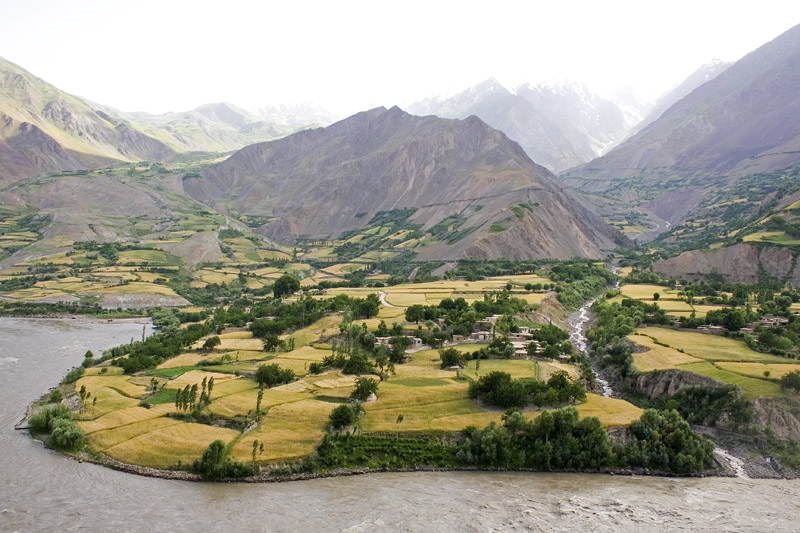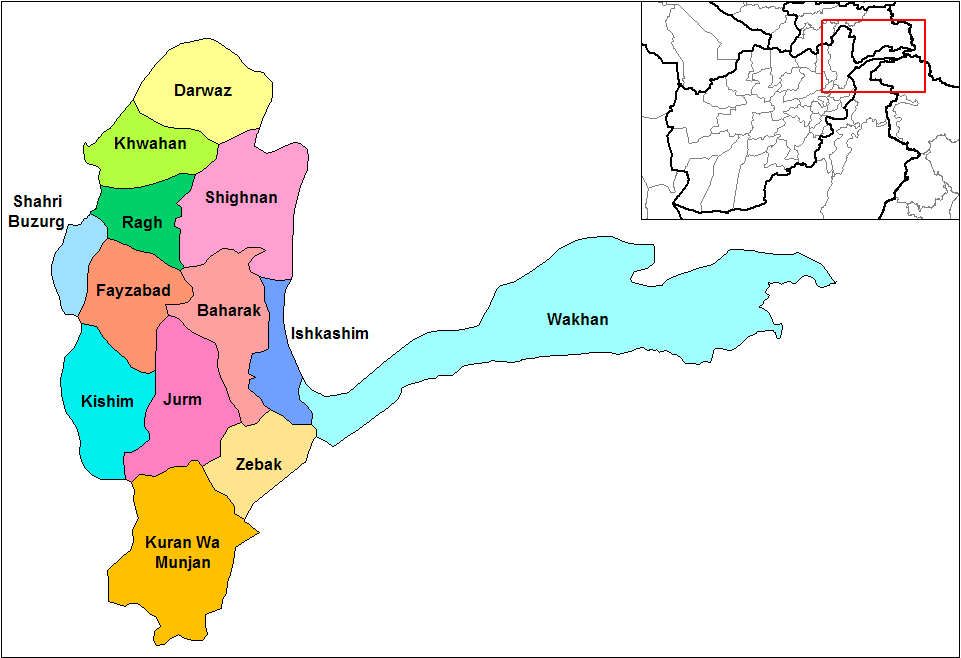|
Kakrak Valley (Bamyan)
Karkak Valley () is a valley in central Afghanistan, located in Bamyan province, 120 km west of Kabul province. The famous Buddhist mural named "The Hunter King" (7-8th centuries CE) shows a typically local royal figure seated on a throne, his bow and arrows on the side. He wears a triple-crescent crown which has been compared to the triple-crescent crowns on the coinage found in northeastern Afghanistan in the area of Zabulistan, such as a coin found in Ghazni. Late 7th to early 8th century CE. Other authors have attributed the triple-crescent crown to Hephthalite influence. The painting may be an allegory of a King abandoning violence, particularly the hunting of animals, and converting to Buddhism."According to Jäger's interpretation, the so-called "Hunter-King" was a symbolic representation of a royal person who converted to Buddhism and abandoned hunting and violence in general." in Murals from Kakrak File:Kakrak Hunter King.jpg, The triple-crescent crown in the "Hunt ... [...More Info...] [...Related Items...] OR: [Wikipedia] [Google] [Baidu] |
Valleys Of Afghanistan
Afghanistan, which is about two-thirds mountainous, contains many valleys. The majority of the valleys are located in parts of northeastern, central, southern and southeastern Afghanistan. The southeastern areas are wetter and are covered by forest with trees such as cypress, oak, populus, poplar, pine etc. The valleys are the most populated regions in the country, and much of the agriculture done takes place either in the valleys or on the high plains. Wakhan Valleys in the Wakhan include: * Sheghnan Valley * Ashava Valley * Darwaz Valley * Drayem Valley * Arsj Valley * Hnjab Valley * Farkhar Valley * Ishkamish District Valley (see Ishkamish District) * Khost i Fereng Valley * Samandan Valley * Andrab Valley * Khenjan Valley * Tala wa Barfak Valley (see Tala wa Barfak District) Southern Hindu Kush Southern Hindu Kush valleys include (among others): * Panj Valley Valley * Korm Valley * Panjdarh Nijrab Valley * Bandavol Valley * Eshpi Valley * Shishil Valley * Kepchaq Valley * ... [...More Info...] [...Related Items...] OR: [Wikipedia] [Google] [Baidu] |
Provinces Of Afghanistan
The provinces of Afghanistan ( ''Wilayah, wilāyat'') are the primary administrative divisions. Afghanistan is divided into 34 provinces. Each province encompasses a number of Districts of Afghanistan, districts or usually over 1,000 villages. Provincial governors played a critical role in the reconstruction of the Afghan state following the creation of the new government under Hamid Karzai. According to international security scholar Dipali Mukhopadhyay, many of the provincial governors of the western-backed government were former warlords who were incorporated into the political system. Provinces of Afghanistan Administrative The following table lists the province, capital, number of districts, UN region, region, ISO 3166-2:AF code and license plate code. Demographic The following table lists the province, population in 2024, area in square kilometers and population density. Regions of Afghanistan The following tables summarize data from the demographic ... [...More Info...] [...Related Items...] OR: [Wikipedia] [Google] [Baidu] |
Districts Of Afghanistan
The districts of Afghanistan, known as ''wuleswali'' (, ''wuləswāləi''; , ''wuləswālī''; ''ulasvolik''), are secondary-level administrative units, one level below Provinces of Afghanistan, provinces. The Afghan government issued its first district map in 1973. It recognized 325 districts, counting ''wuleswalis'' (districts), ''alaqadaries'' (sub-districts), and ''markaz-e-wulaiyat'' (provincial center districts). In the ensuing years, additional districts have been added through splits, and some eliminated through merges. In June 2005, the Afghan government issued a map of 398 districts. It was widely adopted by many information management systems, though usually with the addition of ''Sharak-e-Hayratan'' for 399 districts in total. It remains the ''de facto'' standard as of late 2018, despite a string of government announcements of the creation of new districts. The latest announced set includes 421 districts. The country's Central Statistics Office (CSO) and the Indepe ... [...More Info...] [...Related Items...] OR: [Wikipedia] [Google] [Baidu] |
Bamyan Province
Bamyan, also spelled Bamiyan, Bāmīān or Bāmyān (), is one of the thirty-four provinces of Afghanistan with the city of Bamyan as its center, located in central parts of Afghanistan. The terrain in Bamyan is mountainous or semi-mountainous, at the western end of the Hindu Kush mountains concurrent with the Himalayas. The province is divided into eight districts, with the town of Bamyan serving as its capital. The province has a population of about 495,557 and borders Samangan to the north, Baghlan, Parwan, and Maidan Wardak to the east, Ghazni and Daikundi to the south, and Ghor and Sar-e-Pol to the west. It is the largest province in the Central region of Afghanistan. It was a center of commerce and Buddhism in the 4th and 5th centuries. In antiquity, central Afghanistan was strategically placed to thrive from the Silk Road caravans that crisscrossed the region, trading between the Roman Empire, Han dynasty, Central Asia, and South Asia. Bamyan was a stopping-off ... [...More Info...] [...Related Items...] OR: [Wikipedia] [Google] [Baidu] |
Hazara People
The Hazaras (; ) are an ethnic group and a principal component of Afghanistan’s population. They are one of the largest ethnic groups in Afghanistan, primarily residing in the Hazaristan (Hazarajat) region in central Afghanistan. Hazaras also form significant minority communities in Pakistan, mainly in Quetta, and in Iran, primarily in Mashhad. They speak Dari and Hazaragi, dialects of Persian. Dari, also known as Dari Persian, is the official language of Afghanistan. The Hazaras are one of the most persecuted groups in Afghanistan. Between 1888 and 1893, more than half of the Hazara population was massacred under the Emirate of Afghanistan, and they have faced persecution at various times over the past decades. Widespread ethnic discrimination, religious persecution, organized attacks by terrorist groups, harassment, and arbitrary arrest for various reasons have affected Hazaras. There have been numerous cases of torture of Hazara women, land and home seizur ... [...More Info...] [...Related Items...] OR: [Wikipedia] [Google] [Baidu] |
Afghanistan
Afghanistan, officially the Islamic Emirate of Afghanistan, is a landlocked country located at the crossroads of Central Asia and South Asia. It is bordered by Pakistan to the Durand Line, east and south, Iran to the Afghanistan–Iran border, west, Turkmenistan to the Afghanistan–Turkmenistan border, northwest, Uzbekistan to the Afghanistan–Uzbekistan border, north, Tajikistan to the Afghanistan–Tajikistan border, northeast, and China to the Afghanistan–China border, northeast and east. Occupying of land, the country is predominantly mountainous with plains Afghan Turkestan, in the north and Sistan Basin, the southwest, which are separated by the Hindu Kush mountain range. Kabul is the country's capital and largest city. Demographics of Afghanistan, Afghanistan's population is estimated to be between 36 and 50 million. Ancient history of Afghanistan, Human habitation in Afghanistan dates to the Middle Paleolithic era. Popularly referred to as the graveyard of empire ... [...More Info...] [...Related Items...] OR: [Wikipedia] [Google] [Baidu] |
Bamyan Province
Bamyan, also spelled Bamiyan, Bāmīān or Bāmyān (), is one of the thirty-four provinces of Afghanistan with the city of Bamyan as its center, located in central parts of Afghanistan. The terrain in Bamyan is mountainous or semi-mountainous, at the western end of the Hindu Kush mountains concurrent with the Himalayas. The province is divided into eight districts, with the town of Bamyan serving as its capital. The province has a population of about 495,557 and borders Samangan to the north, Baghlan, Parwan, and Maidan Wardak to the east, Ghazni and Daikundi to the south, and Ghor and Sar-e-Pol to the west. It is the largest province in the Central region of Afghanistan. It was a center of commerce and Buddhism in the 4th and 5th centuries. In antiquity, central Afghanistan was strategically placed to thrive from the Silk Road caravans that crisscrossed the region, trading between the Roman Empire, Han dynasty, Central Asia, and South Asia. Bamyan was a stopping-off ... [...More Info...] [...Related Items...] OR: [Wikipedia] [Google] [Baidu] |
Kabul Province
Kabul (Dari/Pashto: ), situated in the east of the country, is one of the thirty-four provinces of Afghanistan. The capital of the province is Kabul city, which is Afghanistan's capital and largest city. The population of the Kabul Province is over 5.5 million people as of 2022, of which over 85 percent live in urban areas. The current governor of the province is Mohammad Aman Obaid. It borders the provinces of Parwan to the north, Kapisa to the north-east, Laghman to the east, Nangarhar to the south-east, Logar to the south, and Wardak to the west. Geography Kabul is located between Latitude 34-31' North and Longitude 69-12' East at an altitude of 1800 m (6000 feet) above sea level, which makes it one of the world's highest capital cities. Kabul is strategically situated in a valley surrounded by high mountains at crossroads of north-south and east-west trade routes. One million years ago the Kabul region was surrounded from south-east between Lowgar and Paghm ... [...More Info...] [...Related Items...] OR: [Wikipedia] [Google] [Baidu] |
Zabulistan
Zabulistan (, ''Zābolistān'', ''Zāwulistān'' or simply ), is an ancient and medieval name for a historical region that included mainly southeastern region ( Zabol) of Iran and some parts of what is now southern Afghanistan. By the tenth century, Iranian sources mention Zabulistan as part of the Khorasan marches, a frontier region between Khorasan and India. In the '' Tarikh-i Sistan'', finished around 1062 CE, the author regards Zabol as part of the land of Sistan, stretching from the Hamun Oasis all the way to the Indus River. Today, the Iranian city Zabol take their names from the historical region. Zabulistan has become popularized as the birthplace of the character Rostam of Ferdowsi's ''Shahnameh'', in which the word "Zabulistan" is used interchangeably with "Sistan", which is the same historical region, located in present-day eastern Iran ( Sistan and Baluchestan Province) and some parts of southwestern Afghanistan ( Nimruz, Helmand and Kandahar). Names ... [...More Info...] [...Related Items...] OR: [Wikipedia] [Google] [Baidu] |
Ghazni
Ghazni (, ), historically known as Ghaznayn () or Ghazna (), also transliterated as Ghuznee, and anciently known as Alexandria in Opiana (), is a city in southeastern Afghanistan with a population of around 190,000 people. The city is strategically located along Highway 1 (Afghanistan), Highway 1, which follows the path that has served as the main road between Kabul and Kandahar for thousands of years. Situated on a plateau at 2,219 metres (7,280 ft) above sea level, the city is south of Kabul and is the capital of Ghazni Province. The name Ghazni derives from the Persian word ''ganj'', meaning "treasure." Citadel of Ghazni, Ghazni Citadel, the Ghazni Minarets, Minarets of Ghazni, the Palace of Sultan Mas'ud III, and several other cultural heritage sites have brought travelers and archeologists to the city for centuries. During the Pre-Islamic period of Afghanistan, pre-Islamic period, the area was inhabited by various tribes who practiced different religions including Zoro ... [...More Info...] [...Related Items...] OR: [Wikipedia] [Google] [Baidu] |
Hephthalite
The Hephthalites (), sometimes called the White Huns (also known as the White Hunas, in Iranian as the ''Spet Xyon'' and in Sanskrit and Prakrit as the ''Sveta-huna''), were a people who lived in Central Asia during the 5th to 8th centuries CE, part of the larger group of Eastern Iranian Huns. They formed an empire, the Imperial Hephthalites, and were militarily important from 450 CE, when they defeated the Kidarites, to 560 CE, when combined forces from the First Turkic Khaganate and the Sasanian Empire defeated them. After 560 CE, they established "principalities" in the area of Tokharistan, under the suzerainty of the Western Turks (in the areas north of the Oxus) and of the Sasanian Empire (in the areas south of the Oxus), before the Tokhara Yabghus took over in 625. The Imperial Hephthalites, based in Bactria, expanded eastwards to the Tarim Basin, westwards to Sogdia and southwards through Afghanistan, but they never went beyond the Hindu-Kush, which was occupied by ... [...More Info...] [...Related Items...] OR: [Wikipedia] [Google] [Baidu] |








